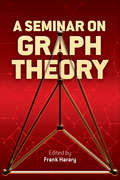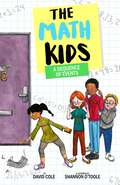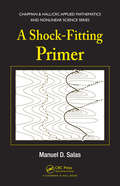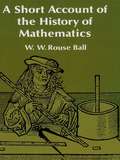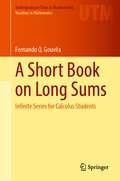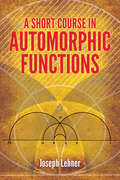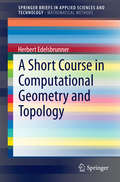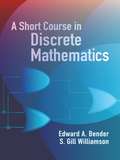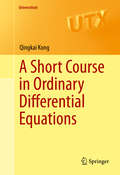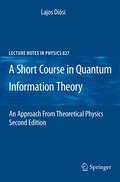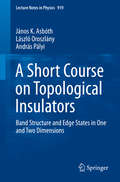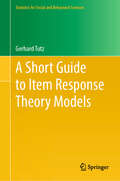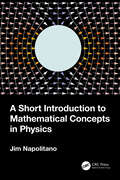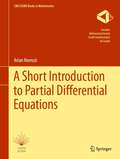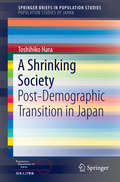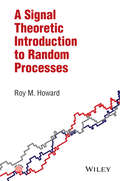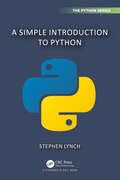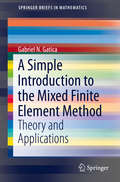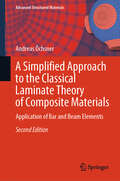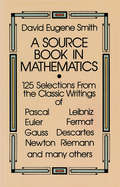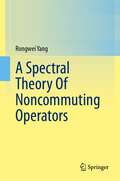- Table View
- List View
A Seminar on Graph Theory (Dover Books on Mathematics)
by Frank HararyPresented in 1962–63 by experts at University College, London, these lectures offer a variety of perspectives on graph theory. Although the opening chapters form a coherent body of graph theoretic concepts, this volume is not a text on the subject but rather an introduction to the extensive literature of graph theory. The seminar's topics are geared toward advanced undergraduate students of mathematics.Lectures by this volume's editor, Frank Harary, include "Some Theorems and Concepts of Graph Theory," "Topological Concepts in Graph Theory," "Graphical Reconstruction," and other introductory talks. A series of invited lectures follows, featuring presentations by other authorities on the faculty of University College as well as visiting scholars. These include "Extremal Problems in Graph Theory" by Paul Erdös, "Complete Bipartite Graphs: Decomposition into Planar Subgraphs," by Lowell W. Beineke, "Graphs and Composite Games," by Cedric A. B. Smith, and several others.
A Sensory Approach to STEAM Teaching and Learning: Materials-Based Units for Students K-6
by Kerry P. Holmes Jerilou J. Moore Stacy V. HolmesDid you know you have the power and the materials at your fingertips to facilitate the actual brain growth of students? This book is a practical resource to engage K-6 students with STEAM content through their five senses: seeing, listening, touch/movement, smell and taste. It combines historical research, practical suggestions, and current practices on the stages of cognitive development and the brain’s physical response to emotion and novelty; to help you learn ways to transform ordinary lesson plans into novel and exciting opportunities for students to learn through instruction, exploration, inquiry, and discovery. In addition to providing examples of sensory-rich unit plans, the authors take you through the step-by-step process on how to plan a thematic unit and break it down into daily seamless lesson plans that integrate science, technology, engineering, arts, and mathematics. With 25 themed STEAM unit plans and activities based on national standards, up-to-date research on brain science, and real classroom experience, this book shows multiple ways to develop and deliver active multisensory activities and wow your students with sights and sounds as soon as they come through the door of your classroom.
A Sensory Approach to STEAM Teaching and Learning: Materials-Based Units for Students K-6
by Kerry P. Holmes Jerilou J. Moore Stacy V. HolmesDid you know you have the power and the materials at your fingertips to facilitate the actual brain growth of students?This book is a practical resource to engage K-6 students with STEAM content through their five senses: seeing, listening, touch/movement, smell and taste. It combines historical research, practical suggestions, and current practices on the stages of cognitive development and the brain’s physical response to emotion and novelty; to help you learn ways to transform ordinary lesson plans into novel and exciting opportunities for students to learn through instruction, exploration, inquiry, and discovery.In addition to providing examples of sensory-rich unit plans, the authors take you through the step-by-step process on how to plan a thematic unit and break it down into daily seamless lesson plans that integrate science, technology, engineering, arts, and mathematics.With 25 themed STEAM unit plans and activities based on national standards, up-to-date research on brain science, and real classroom experience, this book shows multiple ways to develop and deliver active multisensory activities and wow your students with sights and sounds as soon as they come through the door of your classroom.
A Sequence of Events: The Math Kids (Book 2) (The Math Kids)
by David ColeThe Math Kids Club is back! After solving the case of the prime-time burglars, the Math Kids—Jordan, Justin, and Stephanie—are ready to return to the original purpose of their club: solving math problems. And the district Math Olympics is the perfect opportunity to do just that. But before they can enter the competition, they need a fourth teammate. The Math Kids set their sights on Catherine Duchesne. Even though Catherine has been quiet in class, she knows some really cool math tricks that are sure to help the Math Kids win the competition. But when Catherine doesn&’t show up for school and Jordan, Justin, and Stephanie find out her father&’s been kidnapped, the group springs into action to help their new friend. The Math Kids: A Sequence of Events is the second book in the Math Kids series.
A Shock-Fitting Primer (Chapman & Hall/CRC Applied Mathematics & Nonlinear Science)
by Manuel D. SalasA defining feature of nonlinear hyperbolic equations is the occurrence of shock waves. While the popular shock-capturing methods are easy to implement, shock-fitting techniques provide the most accurate results. A Shock-Fitting Primer presents the proper numerical treatment of shock waves and other discontinuities. The book begins by recounting the events that lead to our understanding of the theory of shock waves and the early developments related to their computation. After presenting the main shock-fitting ideas in the context of a simple scalar equation, the author applies Colombeau’s theory of generalized functions to the Euler equations to demonstrate how the theory recovers well-known results and to provide an in-depth understanding of the nature of jump conditions. He then extends the shock-fitting concepts previously discussed to the one-dimensional and quasi-one-dimensional Euler equations as well as two-dimensional flows. The final chapter explores existing and future developments in shock-fitting methods within the framework of unstructured grid methods.Throughout the text, the techniques developed are illustrated with numerous examples of varying complexity. On the accompanying downloadable resources, MATLAB® codes serve as concrete examples of how to implement the ideas discussed in the book.
A Short Account of the History of Mathematics (Dover Books on Mathematics)
by W. W. BallThis is a new printing, the first inexpensive one, of one of the most honored histories of mathematics of all time. When the last revised edition appeared in 1908, it was hailed by mathematicians and laymen alike, and it remains one of the clearest, most authoritative, and most accurate works in the field. Mathematicians welcomed it as a lucid overview of the development of mathematics down through the centuries. Laymen welcomed it as a work which gave them an opportunity to understand the development of one of the most recondite and difficult of all intellectual endeavors, and the individual contributions of its great men.In this standard work, Dr. Ball treats hundreds of figures and schools that have been instrumental in the development of mathematics from the Egyptians and Phoenicians to such giants of the 19th century as Grassman, Hermite, Galois, Lie, Riemann, and many others who established modern mathematics as we know it today. This semi-biographical approach gives you a real sense of mathematics as a living science, but where Dr. Ball has found that the biographical approach is not sufficient or suited to presenting a mathematical discovery or development, he does not hesitate to depart from his major scheme and treat the mathematics in detail by itself. Thus, while the book is virtually a pocket encyclopedia of the major figures of mathematics and their discoveries, it is also one of the best possible sources for material on such topics as the problems faced by Greek mathematicians, the contributions of the Arab mathematicians, the development of mathematical symbolism, and the invention of the calculus.While some background in mathematics is desirable to follow the reference in some of the later sections, most of the book can be read without any more preparation than high school algebra. As a history of mathematics to browse through, or as a convenient reference work, it has never been excelled.
A Short Book on Long Sums: Infinite Series for Calculus Students (Undergraduate Texts in Mathematics)
by Fernando Q. GouvêaThis concise textbook introduces calculus students to power series through an informal and captivating narrative that avoids formal proofs but emphasizes understanding the fundamental ideas. Power series—and infinite series in general—are a fundamental tool of pure and applied mathematics. The problems focus on ideas, applications, and creative thinking instead of being repetitive and procedural. Calculus is about functions, so the book turns on two fundamental ideas: using polynomials to approximate a function and representing a function in terms of simpler functions. The derivative is reinterpreted in terms of linear approximations, which then leads to Taylor polynomials and the question of convergence. Enough of the theory of convergence is developed to allow a more complete understanding of power series and their applications. A final chapter looks at the distant horizon and discusses other kinds of series representations. SageMath, a free open-source mathematics software system, is used throughout to do computations, provide examples, and create many graphs. While most problems do not require SageMath, students are encouraged to use it where appropriate. An instructor’s guide with solutions to all the problems is available. The book is intended as a supplementary textbook for calculus courses; lecturers and instructors will find innovative and engaging ways to teach this topic. The informal and conversational tone make the book useful to any student seeking to understand this essential aspect of analysis.
A Short Course in Automorphic Functions (Dover Books on Mathematics)
by Joseph LehnerThis concise three-part treatment introduces undergraduate and graduate students to the theory of automorphic functions and discontinuous groups. Author Joseph Lehner begins by elaborating on the theory of discontinuous groups by the classical method of Poincaré, employing the model of the hyperbolic plane. The necessary hyperbolic geometry is developed in the text. Chapter two develops automorphic functions and forms via the Poincaré series. Formulas for divisors of a function and form are proved and their consequences analyzed. The final chapter is devoted to the connection between automorphic function theory and Riemann surface theory, concluding with some applications of Riemann-Roch theorem. <p> The book presupposes only the usual first courses in complex analysis, topology, and algebra. Exercises range from routine verifications to significant theorems. Notes at the end of each chapter describe further results and extensions, and a glossary offers definitions of terms.
A Short Course in Computational Geometry and Topology (SpringerBriefs in Applied Sciences and Technology)
by Herbert EdelsbrunnerThis monograph presents a short course in computational geometry and topology. In the first part the book covers Voronoi diagrams and Delaunay triangulations, then it presents the theory of alpha complexes which play a crucial role in biology. The central part of the book is the homology theory and their computation, including the theory of persistence which is indispensable for applications, e. g. shape reconstruction. The target audience comprises researchers and practitioners in mathematics, biology, neuroscience and computer science, but the book may also be beneficial to graduate students of these fields.
A Short Course in Differential Topology (Cambridge Mathematical Textbooks)
by Bjørn Ian DundasManifolds are abound in mathematics and physics, and increasingly in cybernetics and visualization where they often reflect properties of complex systems and their configurations. Differential topology gives us the tools to study these spaces and extract information about the underlying systems. This book offers a concise and modern introduction to the core topics of differential topology for advanced undergraduates and beginning graduate students. It covers the basics on smooth manifolds and their tangent spaces before moving on to regular values and transversality, smooth flows and differential equations on manifolds, and the theory of vector bundles and locally trivial fibrations. The final chapter gives examples of local-to-global properties, a short introduction to Morse theory and a proof of Ehresmann's fibration theorem. The treatment is hands-on, including many concrete examples and exercises woven into the text, with hints provided to guide the student.
A Short Course in Discrete Mathematics (Dover Books on Computer Science)
by Edward A. Bender S. Gill WilliamsonWhat sort of mathematics do I need for computer science? In response to this frequently asked question, a pair of professors at the University of California at San Diego created this text. Its sources are two of the university's most basic courses: Discrete Mathematics, and Mathematics for Algorithm and System Analysis. Intended for use by sophomores in the first of a two-quarter sequence, the text assumes some familiarity with calculus. Topics include Boolean functions and computer arithmetic; logic; number theory and cryptography; sets and functions; equivalence and order; and induction, sequences, and series. Multiple choice questions for review appear throughout the text. Original 2005 edition. Notation Index. Subject Index.
A Short Course in Ordinary Differential Equations (Universitext)
by Qingkai KongThis text is a rigorous treatment of the basic qualitative theory of ordinary differential equations, at the beginning graduate level. Designed as a flexible one-semester course but offering enough material for two semesters, A Short Course covers core topics such as initial value problems, linear differential equations, Lyapunov stability, dynamical systems and the Poincaré--Bendixson theorem, and bifurcation theory, and second-order topics including oscillation theory, boundary value problems, and Sturm--Liouville problems. The presentation is clear and easy-to-understand, with figures and copious examples illustrating the meaning of and motivation behind definitions, hypotheses, and general theorems. A thoughtfully conceived selection of exercises together with answers and hints reinforce the reader's understanding of the material. Prerequisites are limited to advanced calculus and the elementary theory of differential equations and linear algebra, making the text suitable for senior undergraduates as well.
A Short Course in Quantum Information Theory: An Approach From Theoretical Physics (Lecture Notes in Physics #827)
by Lajos DiosiThis short and concise primer takes the vantage point of theoretical physics and the unity of physics. It sets out to strip the burgeoning field of quantum information science to its basics by linking it to universal concepts in physics. An extensive lecture rather than a comprehensive textbook, this volume is based on courses delivered over several years to advanced undergraduate and beginning graduate students, but essentially it addresses anyone with a working knowledge of basic quantum physics. Readers will find these lectures a most adequate entry point for theoretical studies in this field. For the second edition, the authors has succeeded in adding many new topics while sticking to the conciseness of the overall approach. A new chapter on qubit thermodynamics has been added, while new sections and subsections have been incorporated in various chapter to deal with weak and time-continuous measurements, period-finding quantum algorithms and quantum error corrections. From the reviews of the first edition: "The best things about this book are its brevity and clarity. In around 100 pages it provides a tutorial introduction to quantum information theory, including problems and solutions. ... it's worth a look if you want to quickly get up to speed with the language and central concepts of quantum information theory, including the background classical information theory." (Craig Savage, Australian Physics, Vol. 44 (2), 2007)
A Short Course on Topological Insulators: Band Structure and Edge States in One and Two Dimensions (Lecture Notes in Physics #919)
by János K. Asbóth László Oroszlány András PályiThis course-based primer provides newcomers to the field with a concise introduction to some of the core topics in the emerging field of topological insulators. The aim is to provide a basic understanding of edge states, bulk topological invariants, and of the bulk--boundary correspondence with as simple mathematical tools as possible. The present approach uses noninteracting lattice models of topological insulators, building gradually on these to arrive from the simplest one-dimensional case (the Su-Schrieffer-Heeger model for polyacetylene) to two-dimensional time-reversal invariant topological insulators (the Bernevig-Hughes-Zhang model for HgTe). In each case the discussion of simple toy models is followed by the formulation of the general arguments regarding topological insulators. The only prerequisite for the reader is a working knowledge in quantum mechanics, the relevant solid state physics background is provided as part of this self-contained text, which is complemented by end-of-chapter problems.
A Short Guide to Item Response Theory Models (Statistics for Social and Behavioral Sciences)
by Gerhard TutzThis book presents foundational concepts, essential principles, and practical applications of Item Response Theory (IRT). It provides a structured survey of diverse models that have been put forth, emphasizing both their differences and commonalities. The main focus is on modern latent trait theory models which provide measurement tools that clearly separate between person abilities and item parameters. The topics covered include the binary Rasch model, its extensions and alternative binary models, ordinal models and their extensions that account for response styles, the thresholds model, classical test theory, response models for count data, differential item functioning, and explanatory item response models. Tree-based item response models, typically not found in classical IRT textbooks, are also addressed. Applications of the models are illustrated on several data sets from differing areas, showing how models can be fitted and compared. All examples have been computed using R. Code snippets are provided, and the full R code for most of the examples is available online. The book is aimed at graduate students, applied statisticians, and researchers working in psychometrics, educators, and anyone curious about modeling strategies that enhance the precision and validity of their measurement tools. It serves as an introductory guide for beginners while also providing a resource for those seeking an overview of the plethora of available IRT models.
A Short Introduction to Mathematical Concepts in Physics
by Jim NapolitanoMathematics is the language of physics and yet, mathematics is an enormous subject. This textbook provides an accessible and concise introduction to mathematical physics for undergraduate students taking a one semester course. It assumes the reader has studied a year of introductory physics and three semesters of basic calculus, including some vector calculus, but no formal training in differential equations or matrix algebra. It equips readers with the skills and foundational knowledge they need for courses that follow in classical mechanics, electromagnetism, quantum mechanics, and thermal physics. This book exposes students early on to the kinds of mathematical manipulations they will need in upper-level courses in physics. It can also serve as a useful reference for their further studies. Key features: Accompanied by homework problems and a solutions manual for instructors, available upon qualifying course adoption Bridges the gap between calculus and physics, explaining fundamental mathematics (differentiation, integration, infinite series) in physical terms Explores quick extensions into mathematics useful in physics, not typically taught in math courses, including the Gamma Function, hyperbolic functions, Gaussian integrals, Legendre polynomials, functions of a complex variable, and probability distribution functions
A Short Introduction to Partial Differential Equations (CMS/CAIMS Books in Mathematics #11)
by Arian NovruziThis book provides a short introduction to partial differential equations (PDEs). It is primarily addressed to graduate students and researchers, who are new to PDEs. The book offers a user-friendly approach to the analysis of PDEs, by combining elementary techniques and fundamental modern methods. The author focuses the analysis on four prototypes of PDEs, and presents two approaches for each of them. The first approach consists of the method of analytical and classical solutions, and the second approach consists of the method of weak (variational) solutions. In connection with the approach of weak solutions, the book also provides an introduction to distributions, Fourier transform and Sobolev spaces. The book ends with an appendix chapter, which complements the previous chapters with proofs, examples and remarks. This book can be used for an intense one-semester, or normal two-semester, PDE course. The reader is expected to have knowledge of linear algebra and of differential equations, a good background in real and complex calculus and a modest background in analysis and topology. The book has many examples, which help to better understand the concepts, highlight the key ideas and emphasize the sharpness of results, as well as a section of problems at the end of each chapter.
A Shrinking Society: Post-Demographic Transition in Japan (SpringerBriefs in Population Studies)
by Toshihiko HaraThis is the book to focus on a new phenomenon emerging in the twenty-first century: the rapidly aging and decreasing population of a well-developed country, namely, Japan. The meaning of this phenomenon has been successfully clarified as the possible historical consequence of the demographic transition from high birth and death rates to low ones. Japan has entered the post-demographic transitional phase and will be the fastest-shrinking society in the world, leading other Asian countries that are experiencing the same drastic changes. The author used the historical statistics, compiled by the Statistic Bureau, Ministry of Internal Affairs and Communications in 2006 and population projections for released in 2012 by the National Institute of Population and Social Security Research, to show the past and future development of the dependency ratio from 1891 to 2060. Then, utilizing the population life table and net reproduction rate, the effects of increasing life expectancy and declining fertility on the dependency ratio were observed separately. Finally, the historical relationships among women's survival rates at reproductive age, the theoretical fertility rate to maintain the replacement level and the recorded total fertility rate (TFR) were analyzed. Historical observation showed TFR adapting to the theoretical level of fertility with a certain time lag and corresponding to women's survival rates at reproductive age. Women's increasing lifespan and survival rates could have influenced decision making to minimize the risk of childbearing. Even if the theoretical fertility rate meets the replacement level, women's views of minimizing the risk may remain unchanged because for women the cost-benefit imbalance in childbearing is still too high in Japan. Based on the findings, the author discusses the sustainability of Japanese society in relation to national finances, social security reform, family policies, immigration policies and community polices.
A Signal Theoretic Introduction to Random Processes
by Roy M. HowardA fresh introduction to random processes utilizing signal theory By incorporating a signal theory basis, A Signal Theoretic Introduction to Random Processes presents a unique introduction to random processes with an emphasis on the important random phenomena encountered in the electronic and communications engineering field. The strong mathematical and signal theory basis provides clarity and precision in the statement of results. The book also features: A coherent account of the mathematical fundamentals and signal theory that underpin the presented material Unique, in-depth coverage of material not typically found in introductory books Emphasis on modeling and notation that facilitates development of random process theory Coverage of the prototypical random phenomena encountered in electrical engineering Detailed proofs of results A related website with solutions to the problems found at the end of each chapter A Signal Theoretic Introduction to Random Processes is a useful textbook for upper-undergraduate and graduate-level courses in applied mathematics as well as electrical and communications engineering departments. The book is also an excellent reference for research engineers and scientists who need to characterize random phenomena in their research. provides details the prototypical random processes that are fundamental to electrical, electronic, and communication engineering. Consequently, chapter 7-10 coverage includes details of the characterization of random phenomena from an engineering perspective: probability mass function/probability density function evolution, autocorrelation function, and power spectral density. Chapter 11 features an introduction to order statistics, which provides the background for a discussion of the Poisson point random process in Chapter 12. Chapter 13 introduces birth-death random processes and then Chapter 14 provides an introduction to first passage time theory.
A Simple Guide to Technology and Analytics
by Brian J. EvansEveryday technology is constantly changing, and it’s hard to keep up with it at times. What is all this talk about automation, STEM, analytics and super-computers, and how will it really affect my daily life at work and in the home? This book is a simple guide to everyday technology and analytics written in plain language. It starts with explaining how computer networks are increasing in speed so fast that we can do more in less time than ever before. It explains the analytical jargon in plain English and why robotics in the home will be aided by the new technology of the quantum computer. Richly furnished with over 200 illustrations, photos and with minimal equations, A Simple Guide to Technology and Analytics is a ready reference book for those times when you don’t really understand the technology and analytics being talked about. It explains complicated topics such as automated character recognition in a very simple way, and has simple exercises for the reader to fully understand the technology (with answers at the back). It even has explanations on how home appliances work, which are very useful the next time you go shopping for a microwave or TV. Even the Glossary at the back can be used as a quick look-up explanation for those on the go.
A Simple Introduction to Python (Chapman & Hall/CRC The Python Series)
by Stephen LynchA Simple Introduction to Python is aimed at pre-university students and complete novices to programming. The whole book has been created using Jupyter notebooks. After introducing Python as a powerful calculator, simple programming constructs are covered, and the NumPy, MatPlotLib and SymPy modules (libraries) are introduced. Python is then used for Mathematics, Cryptography, Artificial Intelligence, Data Science and Object Oriented Programming.The reader is shown how to program using the integrated development environments: Python IDLE, Spyder, Jupyter notebooks, and through cloud computing with Google Colab.Features: No prior experience in programming is required. Demonstrates how to format Jupyter notebooks for publication on the Web. Full solutions to exercises are available as a Jupyter notebook on the Web. All Jupyter notebook solution files can be downloaded through GitHub. GitHub Repository of Data Files and a Jupyter Solution notebook: https://github.com/proflynch/A-Simple-Introduction-to-PythonJupyter Solution notebook web page: https://drstephenlynch.github.io/webpages/A-Simple-Introduction-to-Python-Solutions.html
A Simple Introduction to the Mixed Finite Element Method: Theory and Applications (SpringerBriefs in Mathematics)
by Gabriel N. GaticaThe main purpose of this book is to provide a simple and accessible introduction to the mixed finite element method as a fundamental tool to numerically solve a wide class of boundary value problems arising in physics and engineering sciences. The book is based on material that was taught in corresponding undergraduate and graduate courses at the Universidad de Concepcion, Concepcion, Chile, during the last 7 years. As compared with several other classical books in the subject, the main features of the present one have to do, on one hand, with an attempt of presenting and explaining most of the details in the proofs and in the different applications. In particular several results and aspects of the corresponding analysis that are usually available only in papers or proceedings are included here.
A Simplified Approach to the Classical Laminate Theory of Composite Materials: Application of Bar and Beam Elements (Advanced Structured Materials #242)
by Andreas ÖchsnerThis book provides a systematic introduction to composite materials, which are obtained by a layer-wise stacking of one-dimensional bar/beam elements. Each layer may have different mechanical properties, but each single layer is considered as isotropic. The major idea is to provide a simplified theory to easily understand the classical two-dimensional laminate theory for composites based on laminae with unidirectional fibers. In addition to the elastic behavior, failure is investigated based on the maximum stress, maximum strain, Tsai-Hill, and the Tsai-Wu criteria. Partial differential equations lay the foundation to mathematically describe the mechanical behavior of any classical structural member known in engineering mechanics, including composite materials. The so-called classical laminate theory provides a simplified stress analysis, and a subsequent failure analysis, without the solution of the system of coupled differential equations for the unknown displacements. The procedure provides the solution of a statically indeterminate system based on a generalized stress–strain relationship under consideration of the constitutive relationship and the definition of the so-called stress resultants. This laminate theory is typically provided for two-dimensional plane problems, where the basic structural element is a simple superposition of a classical plane elasticity element with a thin plate element under the consideration of an orthotropic constitutive law. This two-dimensional approach and the underlying advanced continuum mechanical modeling might be very challenging for some students, particularly at universities of applied sciences. Thus, a reduced approach, the so-called simplified classical laminate theory, has been developed. The idea is to use solely isotropic one-dimensional elements, i.e., a superposition of bar and beam elements, to introduce the major calculation steps of the classical laminate theory. Understanding this simplified theory is much easier and the final step it to highlight the differences when moving to the general two-dimensional case.
A Source Book in Mathematics
by David Eugene SmithThis work presents, in English translation, the great discoveries in mathematics from the Renaissance to the end of the nineteenth century. You are able to read the writings of Newton, Leibniz, Pascal, Riemann, Bernoulli, and others, exactly as the world saw them for the first time. Succinct selections from 125 different treatises and articles, most of them unavailable elsewhere in English, offer a vivid, firsthand story of the growth of mathematics.
A Spectral Theory Of Noncommuting Operators
by Rongwei YangThe main goal of this book is to describe various aspects of the theory of joint spectra for matrices and linear operators. It is suitable for a graduate-level topic course in spectral theory and/or representation theory. The first three chapters can also be adopted for an advanced course in linear algebra. Centered around the concept of projective spectrum, the book presents a coherent treatment of fundamental elements from a wide range of mathematical disciplines, such as complex analysis, complex dynamics, differential geometry, functional analysis, group theory, and Lie algebras. Researchers and students, particularly those who aspire to gain a bigger picture of mathematics, will find this book both informative and resourceful.
